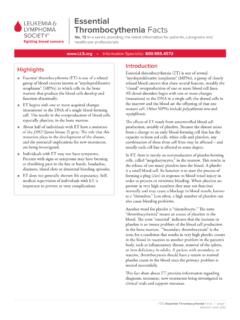Transcription of Acute Promyelocytic Leukemia Facts - Leukemia & …
1 FS26 Acute Promyelocytic Leukemia Facts I page 1 Revised September 2015 Acute Promyelocytic Leukemia FactsNo. 26 in a series providing the latest information for patients, caregivers and healthcare Information Specialist: Acute Promyelocytic Leukemia (APL) is a unique subtype of Acute myeloid Leukemia (AML) in which cells in the bone marrow that produce blood cells (red cells, white cells and platelets) do not develop and function normally. l APL begins with one or more acquired changes (mutations) to the DNA of a single blood -forming cell. APL cells have a very specific abnormality that involves chromosomes 15 and 17, leading to the formation of an abnormal fusion gene PML/RAR . This mutated gene causes many of the features of the In APL, promyelocytes (immature white cells) are overproduced and accumulate in the bone marrow.
2 Signs, symptoms and complications of APL result from the overproduction of promyelocytes and the underproduction of healthy blood cells. l Treatment with a drug called ATRA (all-trans retinoic acid) that targets the chromosomal abnormality, has proven very successful. Probably even more than ATRA, arsenic trioxide (ATO) is also effective as a single agent in APL. Other drug therapies that have increased remission and cure rates include anthracyclines and gemtuzumab ozogamicin (GO). l Because of advances in diagnosis and treatment of this disease, APL is now considered the most curable form of adult Leukemia . Cure rates of 90 percent have been reported from centers specializing in APL A common symptom of APL is bleeding. This is due to reduced numbers of platelets and deficiencies in clotting factors.
3 Bleeding can be life threatening and is managed by treating the APL and by employing supportive measures such as the transfusion of platelets and blood clotting factors. Medical supervision of individuals with APL is important to prevent or treat any disease or treatment complications. IntroductionLeukemia is a cancer of the marrow and blood . The four major types of Leukemia are Acute myeloid Leukemia (AML), chronic myeloid Leukemia (CML), Acute lymphoblastic Leukemia (ALL) and chronic lymphocytic Leukemia (CLL). Each of the main types of Leukemia is further classified into myeloid Leukemia , a cancerous change begins in a marrow cell that normally forms certain blood cells that is, red cells, some types of white cells and platelets. Most people diagnosed with AML have one of the eight subtypes shown in the following 1.
4 AML subtypes based on the French-American-British (FAB) classification. AML cells may have features of red cells, platelets or white cells (monocytes, eosinophils or, rarely, basophils or mast cells) in addition to myeloblasts or promyelocytes. AML subtypes M0 through M5 start in early white cells, subtype M6 starts in early red cells while subtype M7 starts in early platelet Promyelocytic Leukemia (APL) is a unique subtype of Acute myeloid Leukemia . APL is classified as the M3 subtype of AML according to the French-American-British (FAB) system and as APL with translocation between chromosomes 15 and 17 [ t(15;17) ] in the World Health Organization (WHO) classification system. It accounts for about 10 to 15 percent of all adult AML cases diagnosed in the United States each year. With APL, promyelocytes (immature white cells) accumulate in the marrow.
5 These cells stop maturing during the step in blood cell formation that comes after the development Support for this publication provided byTable 1. AML Subtypes Based on the FAB ClassificationFAB SubtypeNameM0 AML minimally differentiatedM1 AML with minimal maturationM2 AML with maturationM3 Acute Promyelocytic leukemiaM4 Acute myelomonocytic leukemiaM4 eosAcute myelomonocytic Leukemia with eosinophiliaM5 Acute monocytic leukemiaM6 Acute erythroid leukemiaM7 Acute megakaryoblastic leukemiaFS26 Acute Promyelocytic Leukemia Facts I page 2 Acute Promyelocytic Leukemia Factsof myeloblasts. They also have a specific chromosome abnormality that involves a translocation of chromosome 15 and chromosome 17 (t15;17).Treatment for APL differs from all other AML treatments. Because of advances in diagnosis and treatment, APL has been transformed from the most fatal to the most curable form of Acute Leukemia in fact sheet provides current information about diagnosis, treatment, new treatments being investigated in clinical trials and support and Incidence Most APL cells have a specific chromosome abnormality involving a balanced translocation (swapping) between chromosomes 15 and 17 (t15;17), resulting in the abnormal fusion gene PML/RAR.
6 This abnormality is not only a distinguishing feature of APL that causes the symptoms of the disease, but also a key target of to data from the National Cancer Institute SEER registry (from 1992 to 2007), the age-adjusted annual incidence (newly diagnosed cases) of APL was per 100,000 persons. During that period, the average age of APL diagnosis was 44 years, which is younger than that of patients with other types of AML. The incidence of APL is equal among males and females. Some reports indicate a higher incidence in Hispanics and a lower incidence for African Americans. APL patients are more often obese than other patients with AML. The disease is most commonly diagnosed in patients ranging from 20 to 50 years of age. With current treatment, APL has become one of the most curable types of Acute Leukemia . People with APL who receive treatment often have a normal or near-normal quality of and Symptoms It is common for people with APL to feel a loss of well-being because of the underproduction of normal blood cells and accumulation of leukemic cells in the bone signs and symptoms of APL includel A pale complexion from anemial Signs of bleeding caused by a very low platelet count , including Black-and-blue marks or bruises occurring for no reason or because of a minor injury The appearance of pinhead-sized red spots on the skin, called petechiae Prolonged bleeding from minor Fatiguel Mild feverl Swollen gumsl Frequent minor infectionsl Loss of appetitel Weight lossl Discomfort in bones or jointsl Enlarged spleenl Enlarged liverl Neurological symptoms (headache, confusion.)
7 Visual changes) associated with APL that involves the central nervous A low platelet count and low amounts of clotting factors predispose patients to bleeding. Bleeding in the brain or lung is serious and can be fatal. However, such bleeding is usually preceded by minor bleeding, such as nosebleeds, blood in the urine or bruises. Infection. Severe infection may be present at the time of diagnosis but it becomes more common and often more serious during treatment, when the bone marrow is completely suppressed. Diagnosis When a patient is suspected of having Leukemia , obtaining an accurate diagnosis of the type of Leukemia is important. The exact diagnosis helps the doctor to estimate how the disease will progress and determine the appropriate course of treatment. Some of the tests used for making a diagnosis may also be repeated during and after therapy to measure the effects of treatment.
8 blood and Bone Marrow Tests. A change in the number and appearance of blood cells helps the doctor to make an accurate diagnosis. APL cells may look similar to normal immature white cells. However, their development is samples are generally taken from a vein in the patient s arm. Samples of marrow cells are obtained by bone marrow aspiration and biopsy. The cells from the blood and marrow samples are examined under a Tests. Karyotyping and fluorescence in situ hybridization (FISH) are tests used to identify certain changes in chromosomes and genes. A laboratory test called a polymerase chain reaction (PCR) may be done in which cells in a sample of blood or marrow are studied to look for certain changes in the structure or function of Acute Promyelocytic Leukemia Facts I page 3 Acute Promyelocytic Leukemia FactsAPL cells have a very specific abnormality called a balanced translocation, in which parts of the chromosomes 15 and 17 are swapped over.
9 This results in the formation of an abnormal fusion gene known as PML/RAR . This mutated gene causes many of the features of the disease. A diagnosis of APL requires demonstration of the 15;17 translocation or of the PML/RAR APL, promyelocytes (immature white cells) are overproduced and accumulate in the bone marrow. Promyelocytes are unable to mature, leading to a significant reduction of white cells and also preventing the development of other normal blood cells. Signs, symptoms and complications of APL result from the overproduction of promyelocytes and the underproduction of healthy blood cells. Doctors use the results of the blood and bone marrow tests to identify the abnormal APL cells. A prompt diagnosis of APL is vital because appropriate treatment must be started immediately in order to avoid the serious and potentially life-threatening complications associated with the this type of Leukemia is suspected, doctors may order coagulation status tests along with other laboratory tests and imaging scans, to help rule out the presence of blood clots.
10 Some conditions that these tests help prevent or diagnose include deep-vein thrombosis, pulmonary embolism and more information about bone marrow tests and other lab tests, please see the free LLS booklet Understanding Lab and Imaging Tests at Planning Treatment decisions are based on the patient s age, general health and APL risk is classified into the two following categories of risk based on the patient s white blood cell count at the moment of diagnosis:l Low risk white blood cell (WBC) count 10,000/microliter ( L) or lessl High risk WBC count greater than 10,000/ , patients with low-risk disease are treated with less intensive regimens than those used for patients at high risk. Nonetheless, every patient s medical situation is different and should be evaluated individually by a hematologist/oncologist, a doctor who specializes in treating blood cancers.














